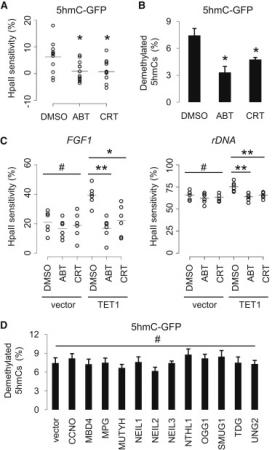这项工作可能有希望得奖。 不过 AIC (activation induced cytidine daminase), MBD4, and GADD45A involved in DNA demethylation work had already been demonstrated in Zebra fish. Tet3 is also involved in active demethylation in ferilized egg (recent paper published in PNAS).
基本上化学机制是: C >5mC>5hmC>5hmU>AP sites>DNA repair by BER>C
Hydroxylation of 5-Methylcytosine by TET1 Promotes Active DNA Demethylation in the Adult Brain
Junjie U. Guo1, 2, Yijing Su1, 3, Chun Zhong1, 3, Guo-li Ming1, 2, 3 and Hongjun Song1, 2, 3, Corresponding Author Contact Information, E-mail The Corresponding Author
1 Institute for Cell Engineering, Johns Hopkins University School of Medicine, Baltimore, MD 21205, USA
2 The Solomon H. Snyder Department of Neuroscience, Johns Hopkins University School of Medicine, Baltimore, MD 21205, USA
3 Department of Neurology, Johns Hopkins University School of Medicine, Baltimore, MD 21205, USA
Received 31 October 2010;
revised 23 January 2011;
accepted 11 March 2011.
Published online: April 14, 2011.
Available online 14 April 2011.
Summary
Cytosine methylation is the major covalent modification of mammalian genomic DNA and plays important roles in transcriptional regulation. The molecular mechanism underlying the enzymatic removal of this epigenetic mark, however, remains elusive. Here, we show that 5-methylcytosine (5mC) hydroxylase TET1, by converting 5mCs to 5-hydroxymethylcytosines (5hmCs), promotes DNA demethylation in mammalian cells through a process that requires the base excision repair pathway. Though expression of the 12 known human DNA glycosylases individually did not enhance removal of 5hmCs in mammalian cells, demethylation of both exogenously introduced and endogenous 5hmCs is promoted by the AID (activation-induced deaminase)/APOBEC (apolipoprotein B mRNA-editing enzyme complex) family of cytidine deaminases. Furthermore, Tet1 and Apobec1 are involved in neuronal activity-induced, region-specific, active DNA demethylation and subsequent gene expression in the dentate gyrus of the adult mouse brain in vivo. Our study suggests a TET1-induced oxidation-deamination mechanism for active DNA demethylation in mammals.
Graphical Abstract
High-quality image (258K)
Highlights
► 5mC hydroxylation promotes active DNA demethylation irrespective of CpG context ► Deamination and base excision repair are involved in 5hmC demethylation ► 5hmC demethylation is highly processive, transcription dependent, and strand biased ► Tet1 and Apobec1 regulate activity-induced DNA demethylation in the mouse brain
Article OutlineIntroductionResults TET1 Promotes DNA Demethylation in Human Cells 5hmC in Both CpG and CpH Contexts Can Be Demethylated in Human Cells 5hmC Demethylation Requires the BER Pathway AID/APOBEC Deaminases Facilitate 5hmC Demethylation 5hmC Demethylation Recapitulates Properties of AID-Mediated Deamination TET1 and AID/APOBEC Deaminases Promote Region-Specific DNA Demethylation in the Adult Mouse Brain Tet1 and Apobec1 Are Involved in Neuronal Activity-Induced DNA Demethylation in the Adult Mouse BrainDiscussionExperimental Procedures DNA Constructs Methylated Reporter Assay and Quantitative Analysis of DNA Methylation Detection and Quantification of 5hmC and 5hmU by Immunoblotting, ELISA, and Immunocytochemistry Methylation and Gene Expression Analysis of the Adult Mouse Dentate GyrusAcknowledgementsFurther ReadingSupplemental InformationReferences








